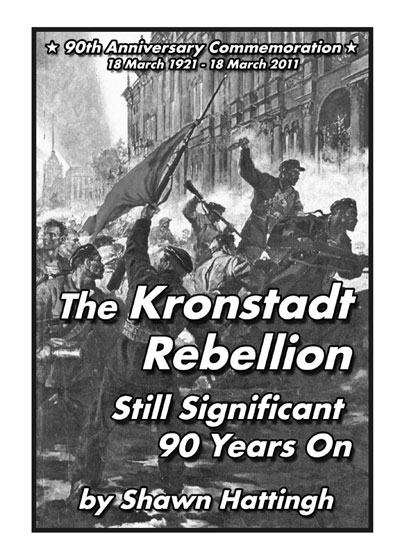Over 30 years of anarchist writing from Ireland listed under hundreds of topics
Review: The Kronstadt Rebellion, Still Significant 90 Years on
 Zabalaza Books, the anarchist printing project linked to the Zabalaza Anarchist Communist Front (ZACF) in South Africa, recently produced this pamphlet to commemorate the Kronstadt uprising in March 1921, when the sailors and workers of the Kronstadt naval base rose up against the Bolsheviks and were slaughtered by the dictatorship.
Zabalaza Books, the anarchist printing project linked to the Zabalaza Anarchist Communist Front (ZACF) in South Africa, recently produced this pamphlet to commemorate the Kronstadt uprising in March 1921, when the sailors and workers of the Kronstadt naval base rose up against the Bolsheviks and were slaughtered by the dictatorship.
As a pamphlet it is excellent - it carries the same style as most Zabalaza pamphlets, with clear and simple presentation and interesting cover art, in this case a painting of a scene from revolutionary Russia. It is available as a PDF in a ready-to-print pamphlet format, which I found very useful to print, being easily readable and with compact texts. Most anarchists would be quite knowledgeable about Kronstadt, but not so much with the Russian Revolution itself, the context of which is extremely important, especially the actions of the Bolsheviks in the lead-up to the uprising. For this reason, the pamphlet first gives a brief timeline of the revolution, starting in Febuary 1917. It outlines the development of soviets (workers’ councils) across the country, and the coalition between the Bolsheviks, anarchists and Left Socialist Revolutionaries that brought down the Provisional Government in October 1917.
This pamphlet is very well referenced, and the use of quotes really does bring home the absolutely counter-revolutionary nature of the Bolsheviks at the time, and the contempt they held for the workers and peasants of Russia. For example, Trotsky is quoted as condemning those who “put the right of workers to elect their own representatives above the Party, thus challenging the right of the Party to affirm its dictatorship even when the dictatorship comes into conflict with the passing moods of the workers’ democracy”. From the moment the Bolsheviks took power, they proceeded to usurp the power of the soviets, establish the Cheka political police, and arrest and murder political opponents, including anarchists and other members of the workers’ movement. Likewise the soldiers were no longer able to elect their officers, and differential rationing was introduced, with the Bolsheviks benefiting.
Several waves of strikes broke out over a short period of years for better wages, over food shortages and against the authoritarian management of the state-controlled industries. It was during one of these strikes, in the city of Petrograd, that the Bolsheviks and the Cheka declared martial law and suppressed the strikers. Hearing of this, a delegation from the Kronstadt naval base travelled to Petrograd to see the real situation for themselves. When they returned to Kronstadt and reported what they had seen the people there were horrified, and they drew up the Petropavlovsk Manifesto through an open soviet process. The pamphlet reprints the manifesto of the Kronstadt rebels, which is very interesting as you can read the ideas and demands of the sailors in their own words. To summarise (as is also done in the pamphlet), the manifesto called for: “free and fair elections to the soviets; freedom of speech for workers, peasants, anarchists and socialists; free trade union activity; and peasants to control land without employing wage labour.” These demands were libertarian and socialist in nature, so the Kronstadt sailors were hardly the capitalist counter-revolutionaries the Bolsheviks claimed them to be. The people of Kronstadt hoped that the matter could be resolved peacefully, and that the Bolsheviks would listen to their demands for a more democratic socialism. The Bolsheviks rejected their proposals, and when the people of Kronstadt founded a new free soviet, Trotsky threatened to shoot them down ‘like partridges’. The Kronstadt uprising was crushed by the Red Army, and the revolution in Russia was over.
So are there any criticisms to be made of this pamphlet? Perhaps more of a mention of the Makhnovists could be made (anarchists who were a major force in Ukraine, where an anarchist society was realised in large parts of that country), to which there is only a short reference. Overall the pamphlet is fantastic, and is a good short introduction to the Russian Revolution, the Kronstadt Uprising and the counter-revolutionary nature of the Bolsheviks. As is stated in the preface of the pamphlet, socialism is enjoying an upsurge in interest due to the capitalist crisis being experienced by most countries of the world, and this pamphlet addresses the need for a democratic socialism, by pointing out the failings and contradictions of an authoritarian Communist dictatorship.
 This article is from Issue 3 of the Irish Anarchist Review - published May 2011
This article is from Issue 3 of the Irish Anarchist Review - published May 2011

